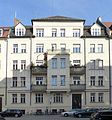Hohenzollernstrasse (Munich)
| Hohenzollernstrasse | |
|---|---|
| Street in Munich | |
| Basic data | |
| State capital | Munich |
| district | Schwabing |
| Hist. Names | Hörmannstrasse |
| Name received | 1892 |
| Connecting roads | Nikolaistraße, Schwere-Reiter-Straße |
| Cross streets | Leopoldstrasse , Wilhelmstrasse, Friedrichstrasse, Römerstrasse, Kurfürstenstrasse , Belgradstrasse , Isabellastrasse, Fallmerayerstrasse, Jakob-Klarstrasse, Ansbacher Strasse, Tengstrasse, Hiltenspergerstrasse, Zentnerstrasse, Schleissheimer Strasse , Winzererstrasse |
| Places | Kurfürstenplatz , Hohenzollernplatz |
| Numbering system | Orientation numbering |
| Buildings | Municipal Hermann-Frieb-Realschule , Nordbad |
| Subway station | Hohenzollernplatz |
| use | |
| User groups | Pedestrian traffic , bicycle traffic , individual traffic , public transport |
| Technical specifications | |
| Street length | about 1.8 km |
The Hohenzollernstraße is a 1.8 kilometer road in the Munich district of Schwabing .
description
It begins on Leopoldstrasse , then runs over Kurfürstenplatz and Hohenzollernplatz and, after Winzererstrasse in the west, joins Schwere-Reiter-Strasse as its extension. Smaller shops predominate between Kurfürstenplatz and Leopoldstrasse. Together with the Leopoldstrasse forming shopping street, the so-called Schwabinger T .
According to a study by the traffic data and SaaS provider Inrix from 2016, Hohenzollernstrasse is the street in Germany with the most traffic jams.
Tram lines 12 and 27 run from Kurfürstenplatz to the west via Hohenzollernstrasse.
history
Until Schwabing was incorporated into Munich in 1890, the castle peace border ran around Munich at the level of Hohenzollernstrasse. In 1892 the street was renamed from its previous name "Hörmannstraße" after the noble family of Hohenzollern . In 1901 Wassily Kandinsky founded his painting school " Phalanx " at Hohenzollernstrasse 6a . Gabriele Münter became his student there. Until 1929 Willibald Besta had his studio at number 104 . From 1902 on, Hohenzollernstrasse 21 was home to the “teaching and experimental studios for applied and fine arts” founded by Wilhelm von Debschitz and Hermann Obrist , which developed into Germany's largest private educational institution. In 1908 Paul Klee taught at her . In 1910 Emil Preetorius was in charge of the school. At number 1, the writer and painter Fanny zu Reventlow, known as the "Schwabinger Scandal Countess", lived for a time . From 1920 to 1930 Joachim Ringelnatz lived in the garden house at Hohenzollernstrasse 31a / I. Werner Heisenberg spent around fourteen years of his youth at Hohenzollernstrasse 110 .
In 1910 Georg Kerschensteiner founded an experimental school in the building built in 1905/1906 at Hohenzollernstrasse 140. In 1938 the building was converted into a military hospital, from 1945 to 1960 it served as the "Surgical Hospital Munich-North". In 1961 a secondary school moved there, where Michael Lerchenberg, for example , went to school. Since 1941, between Zentnerstrasse and Schleißheimer Strasse , Nordbad has been located on Hohenzollernstrasse in a neoclassical style . B. has a grandstand for 1,400 spectators. From 1959 to 2009, Theater44 was located at 44 Hohenzollernstrasse .
By August 1900, a horse-drawn tram had operated on the line from Promenadeplatz to Hohenzollernstrasse. Later tram lines ran from Nikolaiplatz along the entire length of Hohenzollernstrasse to Barerstrasse, Schwere-Reiter-Strasse and Schleißheimer Strasse. In the 1970s, the section between Nikolaiplatz and Kurfürstenplatz was discontinued.
Architectural monuments
There are 33 architectural monuments on Hohenzollernstrasse.
"Girl with a seal", by Ferdinand Liebermann 1930, Hohenzollernplatz
Individual evidence
- ↑ Study: Munich is the German traffic jam capital In: Süddeutsche Zeitung February 21, 2017
- ↑ a b Schwabing-Freimann cultural history trail
- ^ Costumes, high heels and a Buddha In: Süddeutsche Zeitung July 1, 2011
- ↑ Gerhard J. Bellinger, Brigitte Regel-Bellinger: Schwabings Ainmillerstraße and its most important residents: A representative example of Munich's city history from 1888 to today . 2013, ISBN 978-3-8482-6264-9 ( limited preview ).
- ↑ Dirk Heißerer: Where ghosts wander: Literary walks through Schwabing . CHBeck, 2017, ISBN 978-3-406-70253-2 ( limited preview ).
- ↑ Where famous people from Munich lived In: Süddeutsche Zeitung May 21, 2010
- ↑ Schwabing · Space for nonsense potential In: Münchner Wochenanzeiger November 21, 2006
- ^ Münchner Hohenzollernstraße - costumes, high heels and a Buddha In: Süddeutsche Zeitung July 1, 2011
- ↑ Martin Pabst: The Munich Tram. Bavaria's metropolis and its tram . GeraMond, Munich 2000, ISBN 3-932785-05-3 , pp. 14 ( tram magazine. Library ).
- ^ List of monuments for Munich of the BLfD
Web links
- Hohenzollernstrasse - Munich's Alternative Pedestrian Zone In Süddeutsche Zeitung February 11, 2017
Coordinates: 48 ° 9 ′ 37.3 " N , 11 ° 34 ′ 28.2" E






